
Josefsplatz (English: Joseph's Square) is a public square located at the Hofburg Palace in Vienna, Austria. Named after Emperor Joseph II, Josefsplatz is considered one of the finest courtyards in Vienna. [1]

Josefsplatz (English: Joseph's Square) is a public square located at the Hofburg Palace in Vienna, Austria. Named after Emperor Joseph II, Josefsplatz is considered one of the finest courtyards in Vienna. [1]
Josefsplatz is centred on a full-sized equestrian statue and monument of Emperor Joseph II, erected by sculptor Franz Anton von Zauner between 1795 and 1807. [2] Modelled on the statue of Marcus Aurelius on Capitoline Hill in Rome, the statue was commissioned by Emperor Francis II who, from the age of 16, had been raised under the supervision of his uncle, Joseph II. [2] The depiction of Joseph II as a Roman conqueror, dressed in a toga and a laurel wreath, reflects the Habsburg belief that they were descendants of the ancient Roman emperors. [3]
The square is enclosed on three sides by sections of the Hofburg Palace. Facing Augustinerstrasse is the Prunksaal (State Hall), the central structure of the Austrian National Library, which is part of the Hofburg Palace complex—a fine example of late baroque architecture on a grand scale. The building was designed by Johann Bernhard Fischer von Erlach and his son Joseph Emanuel Fischer von Erlach, with side wings later added to the designs by Nikolaus Pacassi. In addition to its function as a library, the building was also designed as a concert hall with superb acoustics. [4] The library museum suffered catastrophic damage in the 1848 battle for Vienna, with the zoological collection being completely destroyed by cannon fire.
To the left of the Prunksaal is the Augustinian wing of the Austrian National Library and the Augustinian Church, the oldest building on the square. [2] To the right of the Prunksaal and facing the Augustinian Church is the Redoutensäle (Redoubt Hall), which was added to the Hofburg complex between 1744 and 1748. [3] The Redoutensäle was badly damaged by fire in 1992.
In the northwest corner of the square is the Stallburg (Stable Palace), the former Imperial Stables, which once housed around nine hundred Lipizzaner horses. Built in the sixteenth century for Archduke Maximillian, the Stallburg housed the art collection of Archduke Leopold Wilhelm between 1614 and 1662. The building was later converted to stables for the Hofburg, surrounding a large courtyard with arcades on three levels with large chimneys. [5] Today the Stallburg houses the Spanish Riding School and the Lipizzaner Museum. [6] [7]
Across from the square are two palaces. The Pallavicini Palace at number 5, completed in 1784, is a blend of baroque and neo-classical styles by Ferdinand von Hohenberg. The Palffy Palace was built in the sixteenth century. [5]
Josefsplatz was featured as a notable location in the film The Third Man (1949).
Josefsplatz was selected as the motif of an Austrian euro collectors' coin: the 5 euro Austrian 2006 EU Presidency commemorative coin, minted on 18 January 2006. The reverse shows the Hofburg Palace in the square. The equestrian statue of Emperor Joseph II is in its center. The wing of the Hofburg can be seen to the right, which contains the Spanish Riding School and the Redoutensäle.
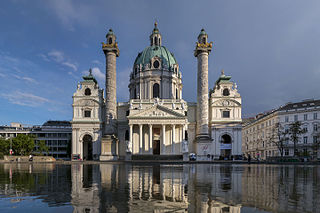
The Rektoratskirche St. Karl Borromäus, commonly called the Karlskirche, is a Baroque church located on the south side of Karlsplatz in Vienna, Austria. Widely considered the most outstanding baroque church in Vienna, as well as one of the city's greatest buildings, the church is dedicated to Saint Charles Borromeo, one of the great counter-reformers of the sixteenth century.
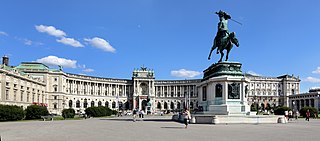
The Hofburg is the former principal imperial palace of the Habsburg dynasty. Located in the centre of Vienna, it was built in the 13th century and expanded several times afterwards. It also served as the imperial winter residence, as Schönbrunn Palace was the summer residence. Since 1946 it is the official residence and workplace of the president of Austria.

The Austrian Crown Jewels are the regalia and vestments worn by the Holy Roman Emperor, and later by the Emperor of Austria, during the coronation ceremony and other state functions. The term refers to the following objects: the crowns, sceptres, orbs, swords, rings, crosses, holy relics and royal robes, as well as several other objects connected with the ceremony. The collection dates from the 10th to the 19th centuries, and it reflects more than a thousand years of European history. It is kept in the Imperial Treasury at the Hofburg Palace in Vienna, Austria.

The Austrian National Library is the largest library in Austria, with more than 12 million items in its various collections. The library is located in the Neue Burg Wing of the Hofburg in center of Vienna. Since 2005, some of the collections have been relocated within the Baroque structure of the Palais Mollard-Clary. Founded by the Habsburgs, the library was originally called the Imperial Court Library ; the change to the current name occurred in 1920, following the end of the Habsburg Monarchy and the proclamation of the Austrian Republic. The library complex includes four museums, as well as multiple special collections and archives.
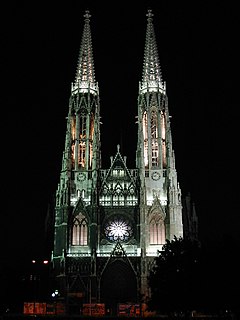
The Votivkirche is a neo-Gothic style church located on the Ringstraße in Vienna, Austria. Following the attempted assassination of Emperor Franz Joseph in 1853, the Emperor's brother Archduke Ferdinand Maximilian inaugurated a campaign to create a church to thank God for saving the Emperor's life. Funds for construction were solicited from throughout the Empire. The church was dedicated in 1879 on the silver anniversary of Emperor Franz Joseph and his wife Empress Elisabeth.
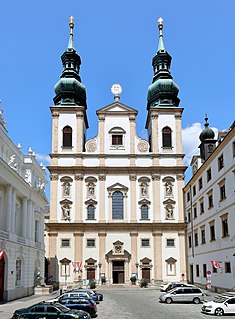
The Jesuit Church, also known as the University Church, is a two-floor, double-tower church in Vienna, Austria. Influenced by early Baroque principles, the church was remodeled by Andrea Pozzo between 1703 and 1705. The Jesuit Church is located on Dr. Ignaz Seipel-Platz, immediately adjacent to the old University of Vienna buildings.
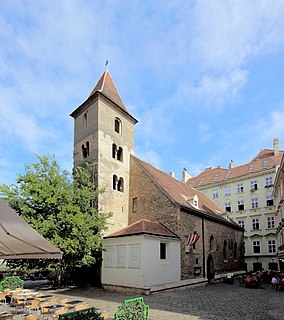
St. Rupert's Church is a Romanesque church in Vienna, Austria. Traditionally considered to be the oldest church in the city, St. Rupert's Church is dedicated to Saint Rupert of Salzburg, patron saint of the salt merchants of Vienna. The church is located in one of the oldest parts of the city, the section of the Roman Vindobona.

Maria-Theresien-Platz is a large public square in Vienna, Austria, that joins the Ringstraße with the Museumsquartier, a museum of modern arts located in the former Imperial Stables. Facing each other from the sides of the square are two near identical buildings, the Naturhistorisches Museum and the Kunsthistorisches Museum. The buildings are near identical, except for the statuary on their façades. The Naturhistorisches' façade has statues depicting personifications of Africa, Asia, Europe, and the Americas. The Kunsthistorisches façade features famous European artists, such as the Dutch Bruegel, among others.
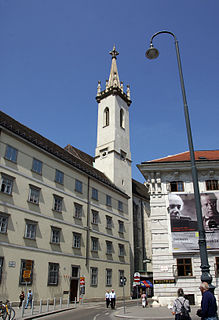
The Augustinian Church in Vienna is a parish church located on Josefsplatz, next to the Hofburg, the winter palace of the Habsburg dynasty in Vienna. Originally built in the 14th century as the parish church of the imperial court of the Habsburgs, the harmonious Gothic interior was added in the 18th century. The official name of church and parish is St. Augustin, but it is locally called Augustinerkirche.
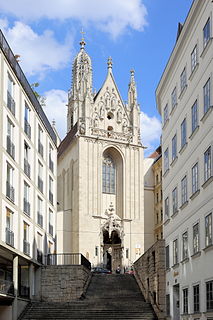
Maria am Gestade is a Gothic church in Vienna, Austria. One of the oldest churches in the city—along with St. Peter's Church and St. Rupert's Church—it is one of the few surviving examples of Gothic architecture in Vienna. Located in the Innere Stadt at Salvatorgasse 12, near the Donaukanal, the church was traditionally used by sailors on the Danube river. The name reflects the former location on the Fluvial terrace of an arm of the Danube river, prior to its regulation.
Due to the stairs surrounding the church it got the popular name Maria Stiegen.

Palais Augarten is a Baroque palace in the district of Leopoldstadt, Vienna, Austria. Constructed in the late seventeenth century by Johann Bernhard Fischer von Erlach on the site of a hunting château and gardens, the palace and gardens were expanded in the nineteenth century under Emperor Franz Joseph I of Austria. Despite extensive damage suffered during World War II, the palace has been maintained almost in its original appearance, and many of the original furnishings can still be found there. Today, Palais Augarten is the home and rehearsal space of the Vienna Boys' Choir, who also have their own school there. The palace is located in the 130-acre Augarten park, which is the oldest Baroque garden in Vienna.
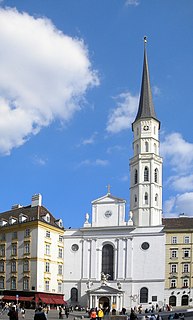
Saint Michael's Church is one of the oldest churches in Vienna, Austria, and also one of its few remaining Romanesque buildings. Dedicated to the Archangel Michael, St. Michael's Church is located at Michaelerplatz across from St. Michael's Gate at the Hofburg Palace. St. Michael's used to be the parish church of the Imperial Court, when it was called Zum heiligen Michael.

Lorenzo Mattielli was an Italian sculptor from the Late Baroque period. His name has also variously been written as Matielli, Mattiely, Matthielli, and Mathielli. He supplied statuary for palaces and churches in Vienna and Dresden and for the monastery of Melk (Austria).

The Stallburg is a renaissance-style building in the Vienna city center located between Josefsplatz and Michaelerplatz. It is part of the Hofburg Palace.

The term "Hofburg fire" refers to any of several major fires that burned in the Hofburg of Vienna, Austria. The Hofburg area has been the documented seat of government since 1279. Each fire destroyed different parts of the Hofburg, in different centuries, and can be termed the "Hofburg fire" due to the historical impact during a particular century:

The Volksgarten is a public park in the Innere Stadt first district of Vienna, Austria. The garden, which is part of the Hofburg Palace, was laid out by Ludwig Remy in 1821. The park was built over the city fortifications that were destroyed by Napoleon in 1809. The Volksgarten was opened to the public in 1823.

The Imperial Treasury at the Hofburg Palace in Vienna, Austria contains a valuable collection of secular and ecclesiastical treasures covering over a thousand years of European history. The entrance to the treasury is at the Schweizerhof, the oldest part of the palace, which was rebuilt in the sixteenth century in the Renaissance style under Holy Roman Emperor Ferdinand I. The Imperial Treasury is affiliated with the Kunsthistorisches Museum, and houses in 21 rooms a collection of rare treasures that were compiled by the Imperial House of Habsburg over the course of centuries, including the Imperial Crown, Orb, and Sceptre of Austria, and the Imperial Regalia of the Emperors and Kings of the Holy Roman Empire, including the Imperial Crown of the Holy Roman Empire.

The Hofgarten is a protected park located on the edge of the Altstadt section of Innsbruck, Austria. The park covers an area of 10 hectares, and borders on the Hofburg, the Kongresshaus, and the Tyrolean State Theatre.

The Winter Palace of Prince Eugene, also known as the City Palace, is a high-Baroque palace in the Innere Stadt district of Vienna, Austria. Located on a narrow street at Himmelpfortgasse 8, the palace was used as the winter residence of Prince Eugene of Savoy, who spent his summers at the Belvedere. The Winter Palace was designed and constructed by Johann Bernhard Fischer von Erlach from 1695 to 1700, and by Johann Lukas von Hildebrandt from 1702 to 1724 following his predecessor's plans.
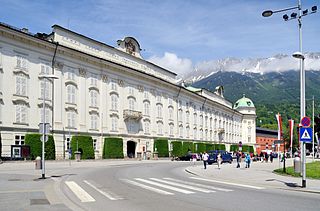
The Hofburg is a former Habsburg palace in Innsbruck, Austria, and considered one of the three most significant cultural buildings in the country, along with the Hofburg Palace and Schönbrunn Palace in Vienna. The Hofburg is the main building of a large residential complex once used by the Habsburgs that still includes the Noblewomen's Collegiate Foundation, the Silver Chapel, the Hofkirche containing Emperor Maximilian's cenotaph and the Schwarzen Mandern, the Theological University, the Tyrolean Folk Art Museum, Innsbruck Cathedral, the Congress, and the Hofgarten.
Coordinates: 48°12′23″N16°22′02″E / 48.206443°N 16.36722°E